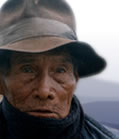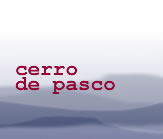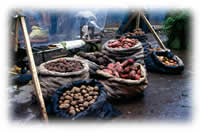 |
 |
||
 |
|||
|
RELATED THEMES development environment livestock OTHER LOCAL THEMES BACKGROUND |
agriculture
Several mention the need for government support, both from agricultural training services and for improved infrastructure, such as irrigation. And at least one man feels that there is potential for agro-industry. Although he talks sadly of how the land produces almost nothing now, is optimistic that agriculture can be revived: "The only way we have of making this change is by irrigation with sprinklers, it's all hanging on this... After the irrigation, what I want is to bring all the villages that have been separated around here back together again. we want to grow apples, maize, carrots. Our idea is to get this irrigation working to bring back our cochinilla (cactus plant)... so we can manufacture coloured pencils around here, or things like that... But if we want to improve our product we need the irrigation" (Peru 8). quotes about agriculture"Here in Pampa we used to produce sugar cane, there were vegetables, fruits, bananas, oranges, papaya, yucca, sweet potatoes. [And now?] Well, Centromin produces refined copper. We're just here, with the copper dust that's ruining our land...none of this area produces anything now. we can't produce maize any more..." "No, they don't grow anything [in Quiulacocha] because unfortunately we don't have the technology neither have we had a consultant from the Ministry of Agriculture. But quite soon this year we're going to sow pastureland which will improve our livestock. But as for food, vegetables et cetera, nothing along those lines, it's not been possible. Once they wanted to grow maca. it didn't work because of what I said.lack of land management technicians who were meant to come and advise. In Carhuamayo - which is at the same altitude - they grow maca, and our region is also very suitable. What we need is the seeds and support in terms of consultancy and then we'd be successful in harvesting the crop. "My grandfather on my mother's side used to tell me that in the old days they'd plant potatoes called shiri. They were white potatoes resistant to the high altitude. That's where the little white chuño (dried) potato comes from. There were other potatoes too: the mauna potato was also resistant to the high altitude and that's what the little black chuño comes from." "I remember when I was small we used to harvest potatoes, corn, coca and barley ... I don't remember ... it was around 1919, 1920. We had the last harvest around then. That was the last harvest sir. It was all planted in the same furrow. We carried on planting but the harvest stopped with the smoke from the foundry, then we left with our animals, we left Huaynacancha." "Yes, the fumes come this way and everything burns as it grows, for example the potatoes, the top of the plant ends up frozen like ice. [We plant] potatoes, carrots, lettuce, carrot. We're still planting things. [But the fumes] ruin the crops, they break and burn, as if they had frozen. The tips of the leaves get burnt like ice. It affects all our produce and it's hard to plant. [People grow] just for themselves. Only some of us plant; others don't because some years it works and others it doesn't. It's been like that for while now." |
|
 Most narrators tell of agriculture in decline. Although livestock was the dominant preoccupation of this farming region, some people produced crops for sale as well as subsistence. One woman recalls:
Most narrators tell of agriculture in decline. Although livestock was the dominant preoccupation of this farming region, some people produced crops for sale as well as subsistence. One woman recalls: